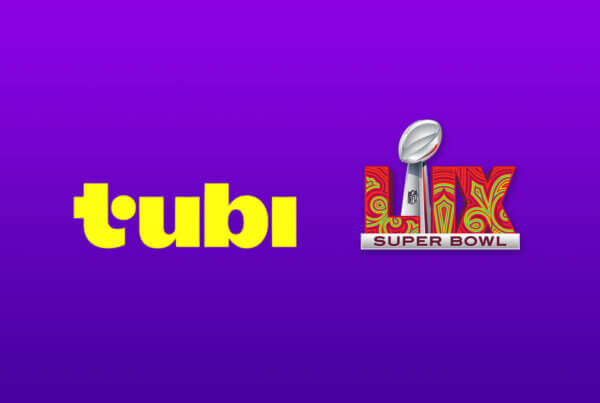Perspectives, measurement, and future trend insights with DPAA
Digital out-of-home (DOOH) advertising continues to rapidly transform the advertising landscape, melding the physical and digital realms and creating dynamic, engaging experiences. Imagine walking through a bustling urban square, where dazzling LED billboards capture your attention while adapting content in real-time to meet the interests of the surrounding throngs. Picture digital screens in your local grocery store that display colorful ad specials—and also interact with you, offering personalized promotions based on your shopping preferences. This is an exciting frontier of advertising, where the boundaries between digital and physical blur, creating immersive moments that captivate consumers on the go.
Behind the flashy screens and eye-catching visuals, DOOH now leverages advanced technologies such as programmatic buying, real-time measurement & analytics, and geotargeting to deliver the right message to the right audience at the right time. Its evolution is driven by the increasing digital enablement of out-of-home media, transforming static billboards into dynamic canvases with kaleidoscopic content creating an array of impactful and measurable touchpoints.
”DOOH is not only merging with cross-channel strategies, but also being empowered by programmatic buying and data-enabled targeting—all while embracing digital enablement and real-time data.
Grant SimmonsVP of Kochava Foundry
DPAA + Kochava
Digital Place-Based Advertising Association (DPAA) recently partnered with Kochava on its research study through Advertiser Perceptions to release the DPAA 2024 Omnichannel Decision Makers Study. The results reveal that DOOH is increasingly recognized as an essential component of the advertising ecosystem, with 79% of study respondents planning to recommend DOOH as part of their media plans over the next 12 months. Of marketers already using DOOH, 96% plan to maintain or increase spend. All told, US advertisers are projected to spend $3.1 billion on DOOH in 2024, a 28% increase from the previous year.
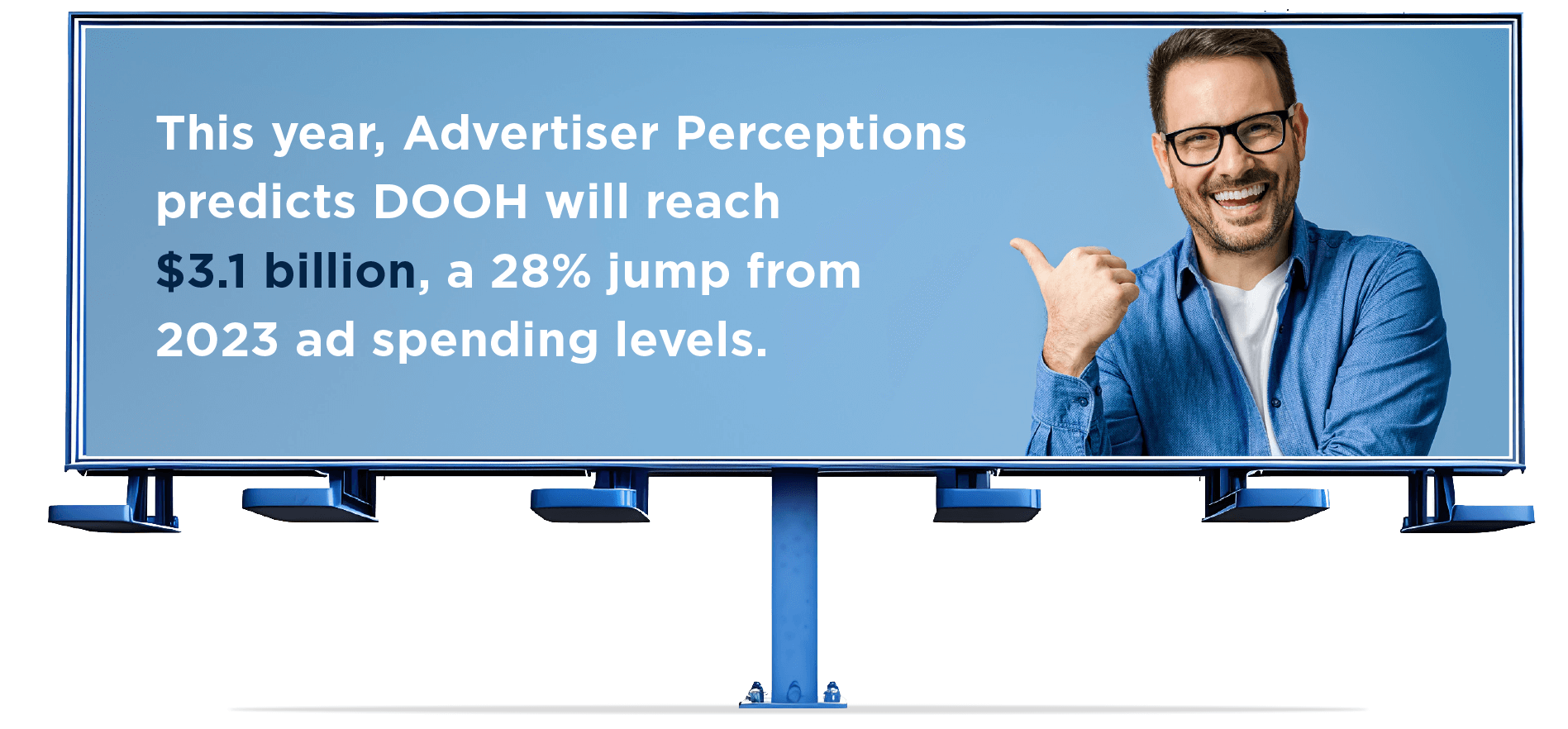
The significance of DOOH in modern advertising is immense: It offers unrivaled opportunities for brands to reach huge numbers of consumers in high-traffic urban spaces, retail environments, transit hubs, and beyond. Let’s unpack how this rapidly growing and rapidly innovating medium is revolutionizing advertising, drawing on key insights from DPAA and Kochava.
First, What Is DOOH?
Digital out-of-home advertising refers to digital media displayed in public spaces, such as digital billboards, screens in transit stations or stores, and interactive kiosks. Unlike traditional out-of-home (OOH) advertising, generally consisting of static images, DOOH utilizes digital technology to display dynamic content that can be updated in real-time, enabling advertisers to deliver relevant and timely messages to their target audiences.
DOOH operates through a network of digital screens managed by tech platforms that control the display, distribution, and timing of ads. These platforms enable programmatic buying, wherein advertisers bid for ad space in real-time based on specific audience criteria, while targeting capabilities ensure that ads effectively reach their optimal audience.
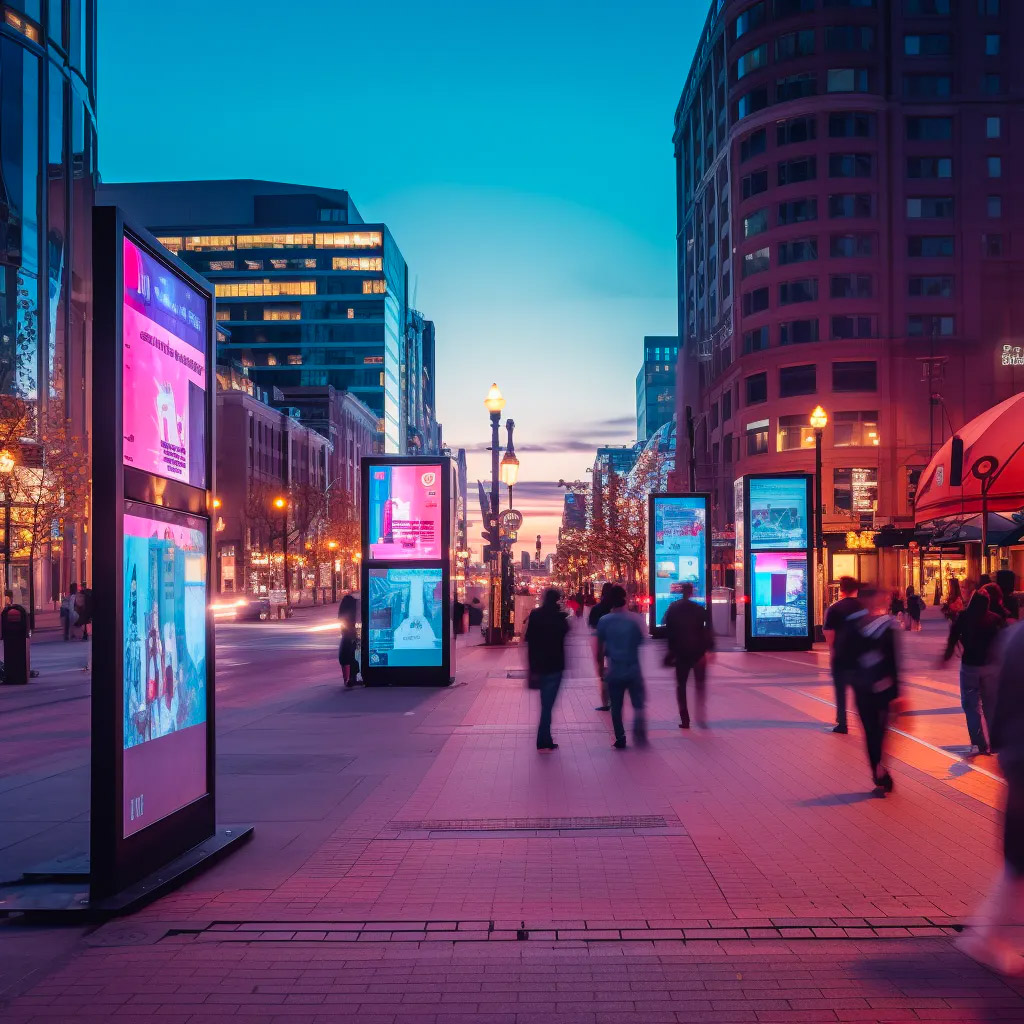
OOH to DOOH: Static to Dynamic
Traditional OOH advertising has long been a marketing staple—think highway billboards or ad content on the side of trains intended to capture the attention of passersby. However eye-catching, the static nature of these ads limits their ability to engage audiences kinetically. DOOH by definition leans into the digital component, allowing for compelling content that can be displayed and updated in real-time.
DOOH Display Innovations
Advancements in DOOH technology in recent years have made the advertising landscape more dynamic, engaging, and interactive. Fundamental to DOOH display is the ability to rotate ads in the same physical space, with digital screens cycling through multiple advertisements. This maximizes infrastructure utilization and increases revenue potential without the need for additional physical installations. Digital screens are more eco-friendly compared to printed billboards, reducing the need for physical materials and waste.
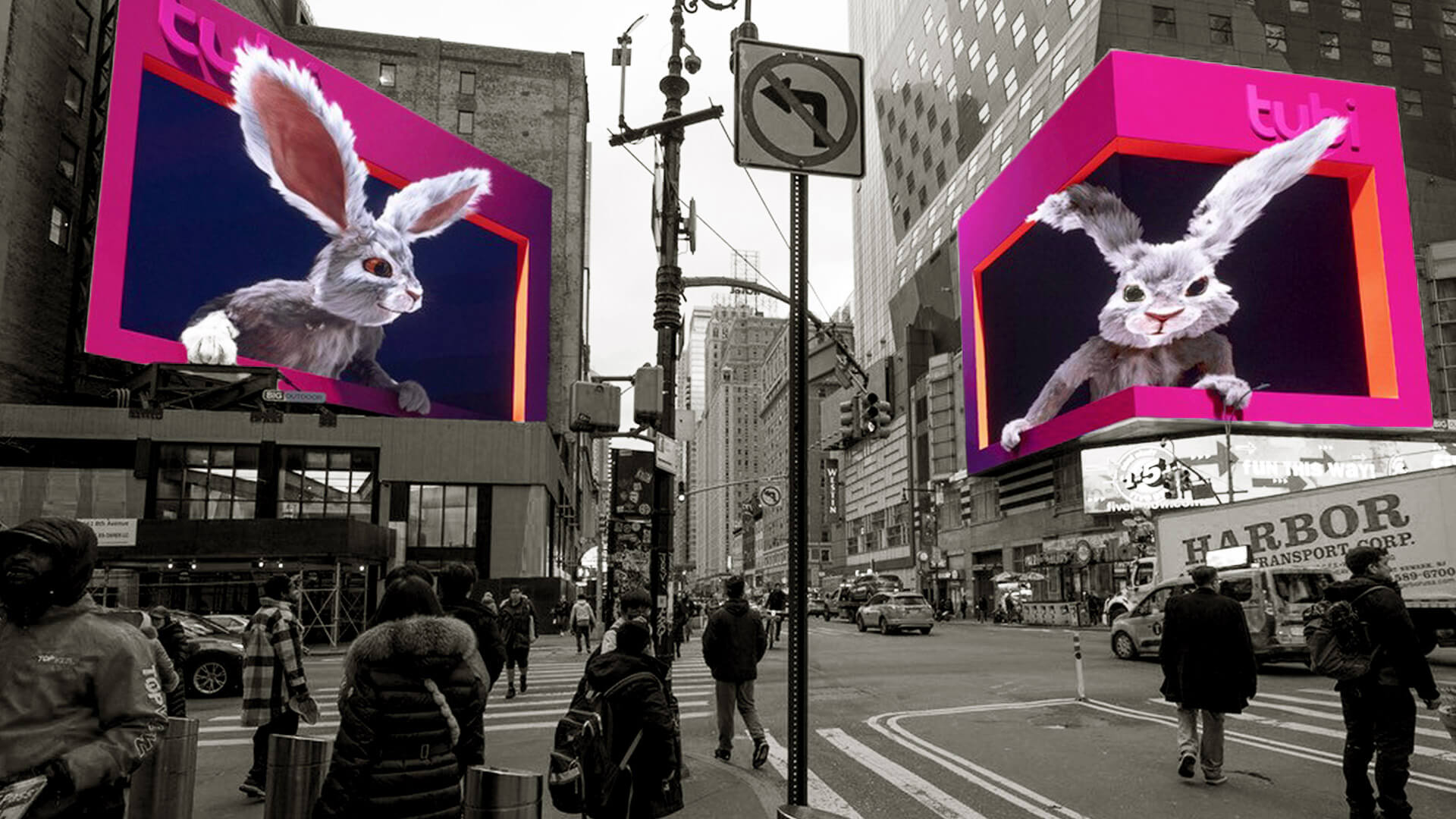
Effects such as innovative lighting installations near DOOH billboards enhance the visual impact by synchronizing with billboard content to create a more striking experience. Full-motion digital billboards feature shifting, personalized creative content, particularly effective for dynamic industries like film. Limitless potential applications are inspiring brands and agencies to develop campaigns specially for full-motion DOOH.
Another attention-grabbing novelty comes from across-space synchronization, in which objects animate over multiple consecutive screens, creating an immersive and cohesive storytelling experience.
Programmatic DOOH & Digital Enablement
The integration of DOOH into cross-channel strategies goes hand in hand with the growing adoption of programmatic buying, enabling advertisers to optimize campaigns in real-time and measure outcomes with greater accuracy. Programmatic DOOH has definitively moved the needle, enabling media buyers to set specific audience and environment criteria such as demographic, time of day, or weather conditions. When these conditions align, the ad automatically displays. This makes the buying process more efficient and ensures that ads are shown to the best audience at the best time.
While awareness of DOOH’s digital enablement is growing among media buyers, it still lags behind reality. Just over half of respondents to the DPAA + Kochava study recognized DOOH as being digitally enabled for everything from data-driven targeting to planning and transacting. In particular, only 51% rated measurement and insights as 4 or 5 out of 5 in their assessment of DOOH’s being fully digitally enabled.
Importance of Measurement and ROI
As DOOH advertising continues to expand its footprint in the advertising landscape, the necessity for robust measurement and attribution solutions becomes increasingly key. Advertisers cannot be satisfied with merely knowing that their ads are being displayed; they require reliable and sophisticated methods to quantify the impact of DOOH investments and how these campaigns contribute to overall marketing success.
Respondents to the question What are your concerns, if any, when considering DOOH in your media plans? reported measurement-related concerns as their top two. Although the percentage of respondents citing these concerns has decreased markedly since 2021, it is still substantial.
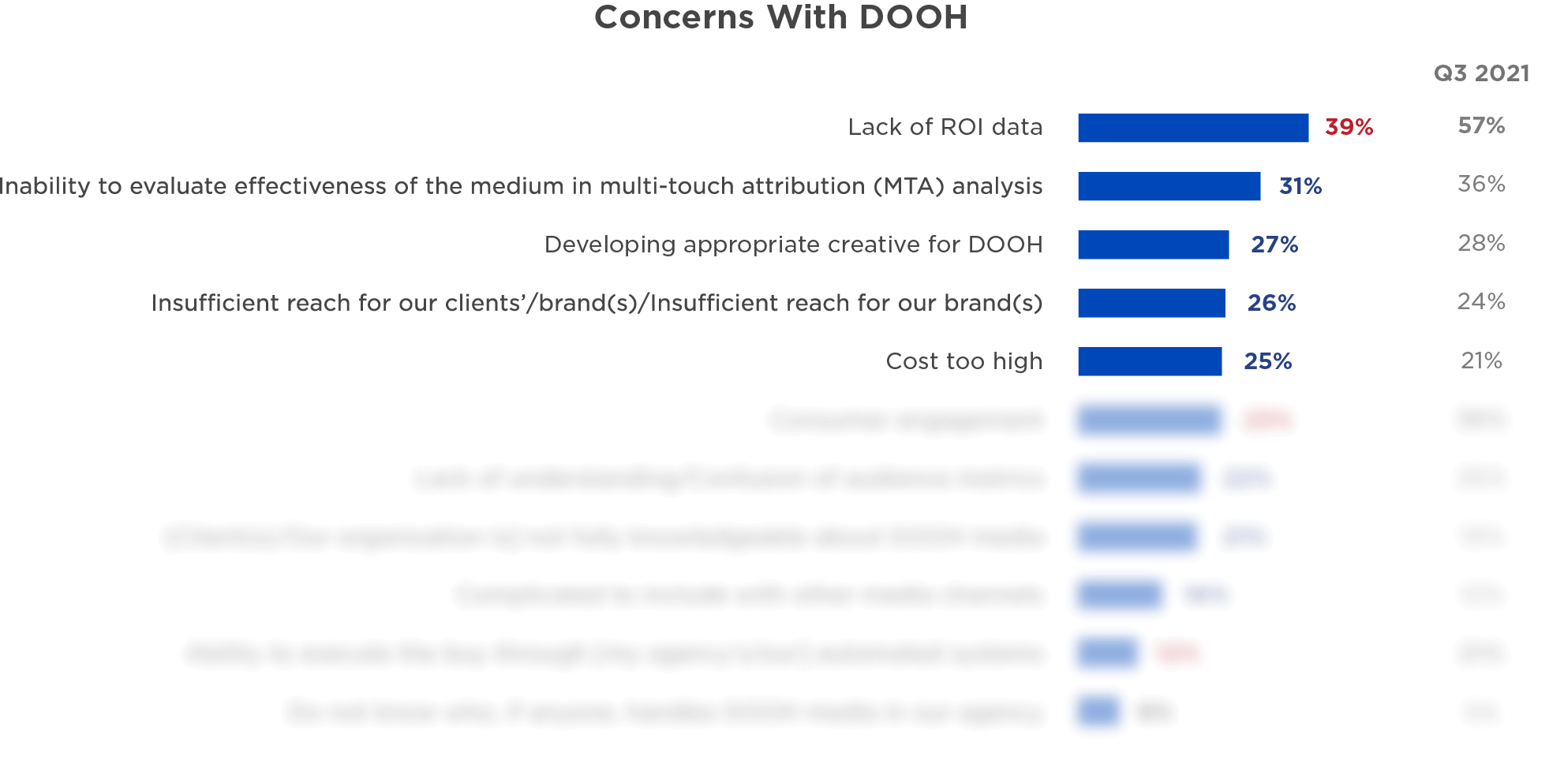
Contrary to the outdated perception that DOOH lacks sophisticated measurement capabilities, the reality is that advanced tools and methodologies are capable of providing reliable and detailed insights, and marketers are gradually coming to recognize this. Advertisers can utilize effective measurement solutions to assess the impact of their DOOH investments, enabling them to justify ad spend, optimize campaign performance, and integrate DOOH seamlessly into broader marketing strategies.
Key Measurement and Attribution Solutions
A variety of solutions including third-party verification, marketing mix modeling (MMM), and multi-touch attribution (MTA) enable advertisers to gain a comprehensive understanding of their DOOH performance and make informed decisions. Ultimately, these solutions will ensure that DOOH fully takes its place as an invaluable and integral medium of the modern marketing mix.
Third-Party Verification
Third-party verification is essential for ensuring that ad impressions are viewable and accurately measured. This involves independent verification services that confirm that an ad was actually seen by the intended audience. Third-party verification helps eliminate discrepancies and offers advertisers confidence that their ads are delivered as promised. This level of transparency is crucial for building trust and ensuring that advertising budgets are being used effectively.
Marketing Mix Modeling (MMM)
MMM is a holistic statistical analysis methodology used to assess the relative impact of myriad marketing elements on sales and other performance metrics. For DOOH, MMM can validate the business impact of campaigns by parsing how the various components of the marketing mix all contribute to overall performance. This enables advertisers to understand the ROI of their DOOH investments in the context of an entire marketing strategy. By incorporating DOOH into MMM, advertisers can make informed, inclusive decisions about budget allocation and campaign optimization.
Multi-Touch Attribution (MTA)
MTA tracks the consumer journey across multiple touchpoints to attribute specific actions to DOOH exposure. Unlike traditional attribution models that may consider only the last touchpoint before a conversion, MTA provides a more comprehensive view of how different interactions contribute to the final outcome. This is particularly important for DOOH, whose memorable visual impact often serves as the initial touchpoint driving awareness and engagement. By understanding the role of DOOH in the broader consumer journey, advertisers can better assess its effectiveness and systematize campaigns accordingly.
Key Benefits of DOOH Advertising
DOOH offers a wide range of advantages that make it a powerful tool in the modern marketing arsenal. Technological innovations offer unprecedented opportunities to create highly engaging and targeted campaigns. Advertisers can exploit DOOH’s flexibility and real-time adaptation to adjust campaigns nimbly in response to current events, consumer feedback, or even inventory levels.
Data-driven targeting enables marketers to pinpoint audiences based on specific geography, times of day, or topical events. Leveraging technologies such as QR codes, social media hashtags, and augmented reality, DOOH offers the possibility of seamless integration with mobile and online platforms, creating an immersive cross-channel consumer experience. This amplifies the reach of a campaign while engaging consumers in an interactive, memorable way.
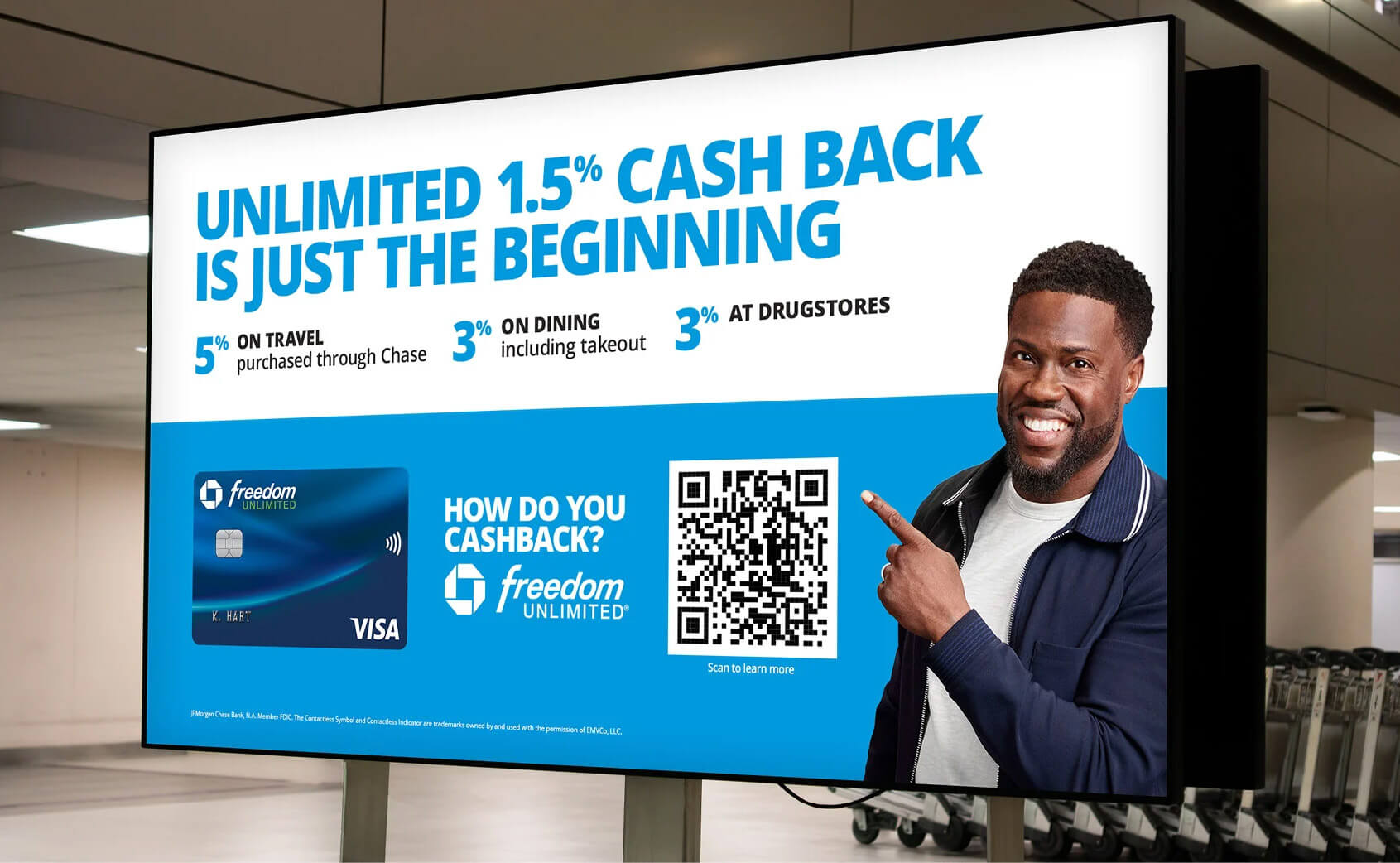
For consumers, these advancements mean more enjoyable and relevant advertising experiences. In addition to commercial content, digital screens provide timely, practical information such as weather or transit alerts. Such utilities make DOOH a valuable info source as well as an entertaining advertising medium.
Integration With Broader Marketing Strategies
Integration of DOOH measurement and attribution solutions with broader marketing strategies is paramount. In the DPAA + Kochava study, complementing a digital plan was cited as the top reason media buyers include DOOH in their media plans.
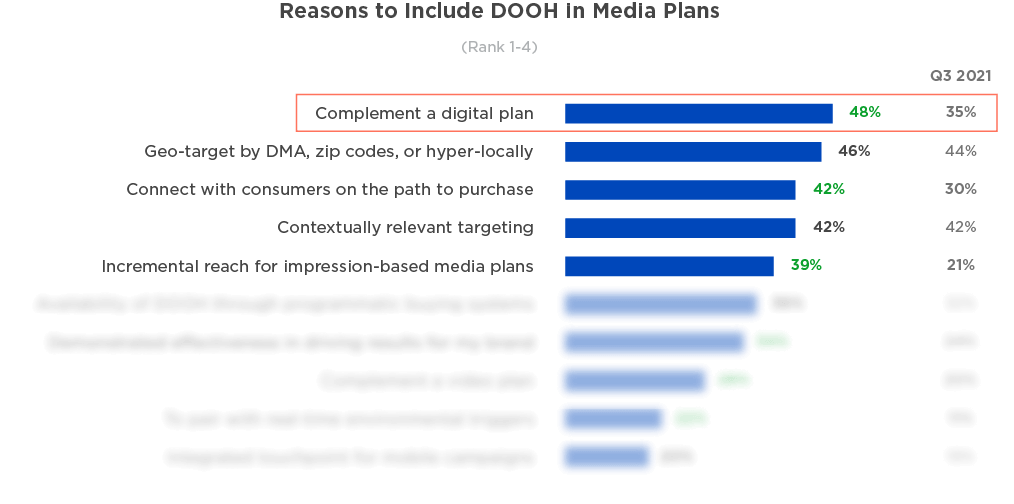
Linking DOOH data with other channels, such as connected (CTV) and mobile, enables advertisers to take in a comprehensive view of their marketing efforts, allowing for more accurate measurement of cross-channel performance and revealing synergies among various marketing strategies. For example, an advertiser might use DOOH to drive awareness, then retarget those exposed to the ad with personalized messages on their mobile or CTV devices. By understanding how DOOH fits into the broader marketing ecosystem, advertisers can maximize the impact of their campaigns and achieve better overall results.
Future Trends for DOOH
As the DOOH advertising landscape continues to evolve, several key factors are poised to shape its future, showcasing the transformative potential of DOOH as it integrates cutting-edge technology and sustainability practices to create more engaging and responsible advertising solutions.
Future DOOH displays will become increasingly intelligent, leveraging location-based marketing to present highly relevant advertising based on where the viewer is. These ads may synchronize with mobile devices, ensuring a seamless and contextually relevant experience. Marketers will devise campaigns that transition smoothly from DOOH to mobile to web, creating a cohesive experience across multiple platforms.
Artificial intelligence (AI) will play a crucial role in dynamically personalizing ad content based on real-time factors. Moreover, AI will offer precise modeled metrics on ad views, including detailed consumer characteristics, enabling advertisers to optimize campaigns effectively and calculate ROI more accurately. Machine learning algorithms promise to facilitate real-time programmatic auctions of DOOH ad spaces, making the buying process even more efficient and tailored to specific audience segments.
Virtual and augmented reality technologies will introduce new layers of interaction and engagement in DOOH advertising. Brands may leverage virtual reality (VR) to offer fully immersive, 360-degree ad experiences within public spaces, captivating audiences and providing a deeper level of engagement. Augmented reality (AR) filters on DOOH displays could enable consumers to visualize products in a real-world setting via their smartphones, enhancing the consumer’s connection to brands and/or products. Both technologies will lead to the creation of on-the-spot, interactive product demonstrations or hands-on experiences.
The development and adoption of low-energy, including solar-powered, displays will significantly reduce electricity costs and appeal to environmentally conscious consumers and brands. An increasing number of vendors will manufacture displays using recyclable or biodegradable materials, furthering the industry’s commitment to sustainability.
DPAA + Kochava White Paper
The DPAA 2024 Omnichannel Decision Makers Study, featuring research from Advertiser Perceptions, offers many valuable insights into the current state and future trends of DOOH advertising. These attest to the growing importance of the medium, as well as the opportunities for marketers eager to explore its full potential and stay on the cutting edge of the rapidly evolving advertising ecosystem.
The study notes a marked uptick in advertiser awareness and understanding of DOOH, with 42% of respondents reporting a moderate increase in their knowledge over the past year. Such heightened awareness is a positive sign for the DOOH industry, suggesting that advertisers are more open to exploring and leveraging DOOH within their broader media strategies.
Moreover, DOOH is considered an extension of TV and video planning by 41% of decision makers. Video Everywhere is widely used as a synonym for DOOH as the genre evolves, as evidenced by the title of DPAA’s annual summit.
Want to Read the Full Report?
The full report and white paper are available to all DPAA members here. If you’re an existing Kochava customer and have not already received your copy of the white paper via email, please contact your client success manager or email Support@Kochava.com.
If you’re an advertiser, an agency, or a DOOH company and need help with measurement, get in touch with the Kochava team here.


